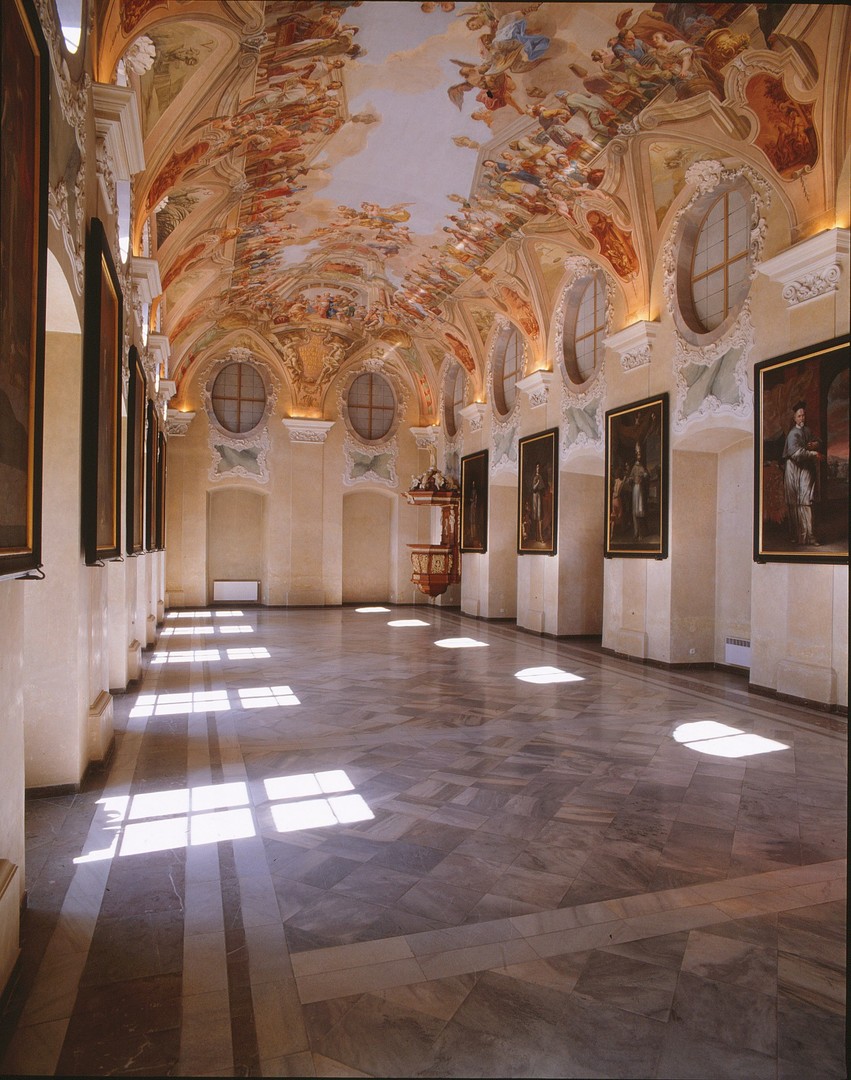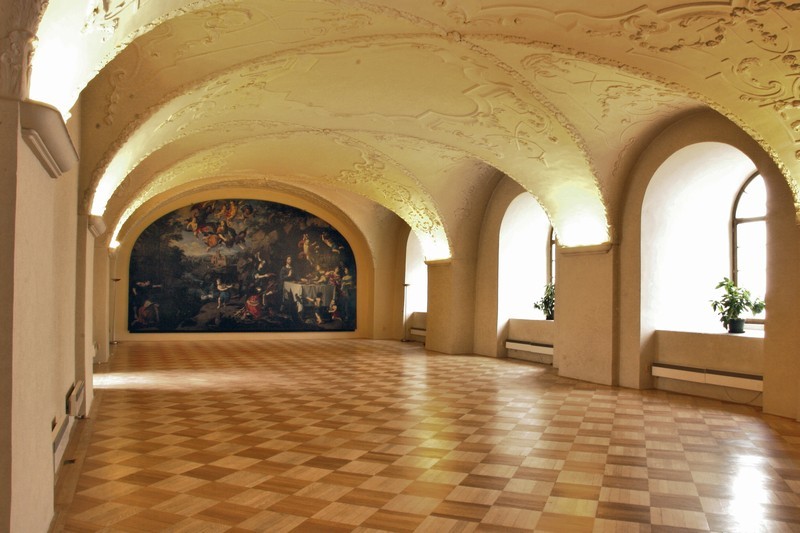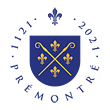Convent Building
Ambits
The original Romanesque cloisters 40 metres in length were reconstructed at the turn of the 17th century. On the inside walls limestone ashlar masonry has been preserved. In the east part there is a partially reconstructed entrance to the Romanesque capitular hall. In the corners there are partially preserved frescos by Siard Nosecký dated 1727, with themes from the life of St. Norbert.
Paradise court
In the centre of the atrium there is a unique trapezoid tank measuring 13 x 11 metres. Its Romanesque foundations were discovered in the 1950s. At the beginning of the 1990s the pool was restored. It is supplied with water from the monastery's historical water system.
Chapter Hall
 It was built between 1750 and 1753 after the original Romanesque hall, damaged during the bombing of Prague by the French army in 1742, was torn down. The vault is decorated with a fresco by Siard Nosecký with the theme of "Rise and Walk - a Man Healed at the Pool of Bethseda." The altar, with the painting "Beatific Heřman Josef before Virgin Mary", was inspired by A. Van Dyck. The walls are adorned with a cycle of paintings by Franz Lichtenreiter: St. Norbert; Beatific Gertrude; Beatific Milo; Beatific Gerlak; St. Siard; St. Gottfried; St. Augustine.
It was built between 1750 and 1753 after the original Romanesque hall, damaged during the bombing of Prague by the French army in 1742, was torn down. The vault is decorated with a fresco by Siard Nosecký with the theme of "Rise and Walk - a Man Healed at the Pool of Bethseda." The altar, with the painting "Beatific Heřman Josef before Virgin Mary", was inspired by A. Van Dyck. The walls are adorned with a cycle of paintings by Franz Lichtenreiter: St. Norbert; Beatific Gertrude; Beatific Milo; Beatific Gerlak; St. Siard; St. Gottfried; St. Augustine.
Romanesque halls with an exhibition dedicated to the founder of the Premonstratensian Order, St. Norbert, and the history of the Strahov Monastery.
The premises of the former monastery cellarium, i.e. pantry. The original double nave premises from the turn of the 13th century were adapted at the beginning of the 17th century in the Renaissance style and a Baroque vault was added between 1671 and 1674. In 1950 the premises acquired their present appearance.
In the first hall, there is a detailed model of the whole area of the monastery in 1:100 scale, the second hall is dedicated to the Premonstratensian Order, and the creation and development of the Strahov Monastery. Photos with audio commentary show the monastery including the seclusion, i.e. the premises inaccessible to the public, which exclusively serve the members of the order.
The third part of the exhibition is a cycle of monumental paintings by J.J. Hering from the beginning of the 17th century depicting scenes from the life of St. Norbert, the founder of the Premonstratensian Order. There are also artefacts which are used once every fifty years during the celebration of the transfer of his remains to Prague.
Summer Refectory
 The refectory dating back to 1691 was designed by Jean Baptiste Mathey, a Burgundy architect. Along the walls there is a portrait gallery with paintings from the end of the 17th century showing significant personalities of the Strahov Monastery. A rood screen is hung on the walls that was used for reading during meals. The vault is decorated with a fresco by Premonstratensian painter Siard Nosecký (1693-1753) and has the theme "Heavenly Feast of the Righteous with the Christ as the Host" dating 1743-1745.
The refectory dating back to 1691 was designed by Jean Baptiste Mathey, a Burgundy architect. Along the walls there is a portrait gallery with paintings from the end of the 17th century showing significant personalities of the Strahov Monastery. A rood screen is hung on the walls that was used for reading during meals. The vault is decorated with a fresco by Premonstratensian painter Siard Nosecký (1693-1753) and has the theme "Heavenly Feast of the Righteous with the Christ as the Host" dating 1743-1745.
Winter Refectory
 The refectory built at the end of the 17th century for the members of the convent to dine during the cold months of the year. The vault of the hall is covered in stucco ornaments; on the front wall there is a large painting by Jan Jiří Heinsch (1647 - 1712) with the theme of Christ after the Fast Served by the Angels. The painting was created for the refectory of the professional Jesuit house in the Lesser Town of Prague. It was brought to Strahov at the end of the 18th century.
The refectory built at the end of the 17th century for the members of the convent to dine during the cold months of the year. The vault of the hall is covered in stucco ornaments; on the front wall there is a large painting by Jan Jiří Heinsch (1647 - 1712) with the theme of Christ after the Fast Served by the Angels. The painting was created for the refectory of the professional Jesuit house in the Lesser Town of Prague. It was brought to Strahov at the end of the 18th century.

